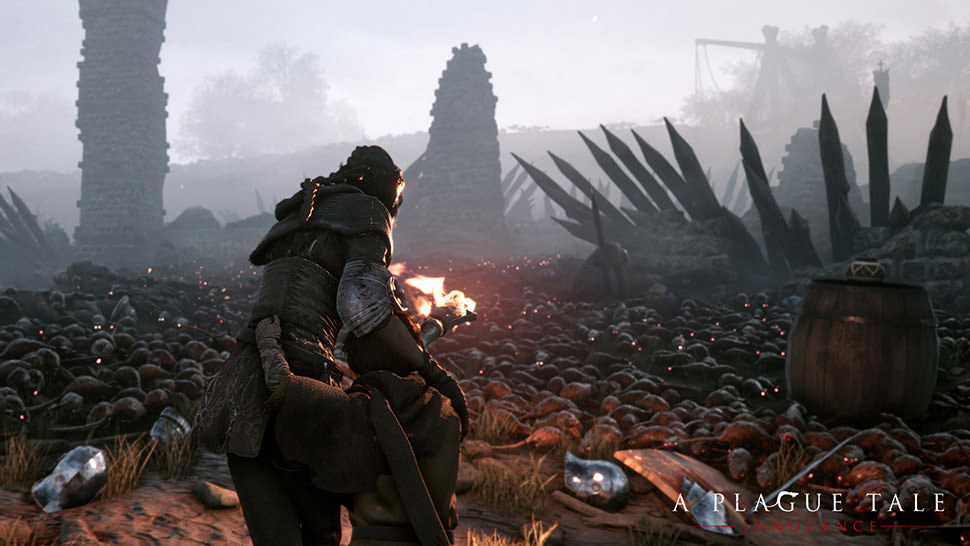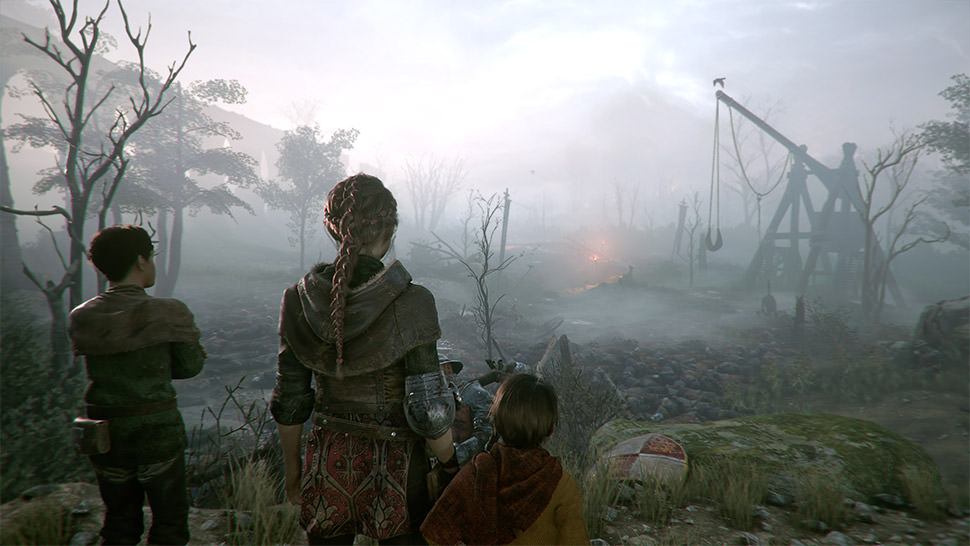A Plague Tale: Innocence Review

 By Kevin Mitchell | May 12, 2019
By Kevin Mitchell | May 12, 2019
Nearly two years ago, I received my first glimpse at the stealth-focused adventure title, A Plague Tale: Innocence. The Middle Ages were already a difficult time to live through in Europe, especially for the poor; however, war, the Inquisition, and the Black Death (Great Plague) were a threat to everyone regardless of social class. Asobo Studio has perfectly created an emotional tale following two young siblings struggling to survive against overwhelming odds during one of the grimmest and darkest periods in history.
Being raised as the daughter in a noble aristocratic family in the 14th century, Amicia de Rune must protect her younger brother Hugo, who up until this point has been confined/quarantined to his room due to an unknown illness. Their mother has been working tirelessly to cure him, ignoring Amicia in the process, but it isn't long before tragedy strikes when the Inquisition comes barging through the estate, leaving a trail of blood and bodies. Their goal: capture the youngest son of the de Rune family. Amicia becomes entrusted with her brother's protection, even though she has barely seen him since his birth.

Considering Hugo has been restricted to the castle for his entire life, one of the many pleasures in the game is watching his curious nature interacting with wild animals you'll come across as you journey through the French countryside. The narrative unfolds through each of the game's seventeen chapters, starting with the simple task of visiting a doctor by the name of Laurentius (who may be able to cure Hugo) in the nearby town. It's not long before things begin to fall apart as the town itself is full of death and decay, leading to Amicia and Hugo fleeing for their lives. Although you'll be spending the majority of the game hand-in-hand with Hugo, it never feels like a hindrance, unlike many games that feature escort quests. However, Hugo will panic and draw attention to himself if you venture too far from him. Along the way, you'll interact with new characters, each with their own backstory and reason for assisting you. Each provides much-needed support, whether it comes from a pair of sneaky thieves that can pick any lock or provide a much-needed distraction, an inspiring alchemist that seemingly always has something new for you to craft, or a blacksmith's son who uses his physical prowess to his advantage.

The game's focus comes from the use of stealth, sticking to the shadows to avoid more than just the Inquisition. Although Amicia does use her slingshot throughout, both to dispose of enemy patrols and to solve environmental puzzles (such as breaking chains or distracting patrols), the game does not shy away from the grisly and macabre theme of the period. If you allow a sword-wielding soldier to charge directly towards you unimpeded, you'll witness a gruesome death for Amicia, as the sword horrifically pierces through her body. I wish I could tell you that is the worst you will face (I wish I could); however, setting a title within the same period as the Black Death means only one thing: rats...and lots of them.
The rats have been a main gameplay component since the initial reveal and gameplay walkthrough a few years back. Your first interaction with these beady-eyed pests is not only highly cinematic but genuinely terrifying at the same time. If you aren't careful, their glowing red eyes and constant, gnawing squeaking may be the last thing you see and hear before you become fully engulfed by the creatures without remorse. Whether you are in the middle of a spooky graveyard on the outskirts of a town or the ruins of an ancient dilapidated castle, the rats can (and will) find their way through every crevice and crack. Even the safety of a forest isn't enough to save you, as hundreds and even thousands of these unholy creatures burst through the ground, saturating the landscape like a wave breaking over a beach. The only guarantee for survival? Light.

As much as the game is a tale about character growth and hardship between siblings, it also profoundly symbolizes the dynamic between light versus dark, good versus evil. Light becomes a death sentence to the rats, and light can come from many forms. The Inquisition learns this quite swiftly, as almost every soldier carries a torch or lantern. They have even devised a way to illuminate pathways using makeshift medieval spotlights (that can also swivel). A burning torch (or stick) can safely guide you through hordes of rats, and the game doesn't shy away from allowing you to use this knowledge to your advantage against your foes. Although the game is quite linear with most branching paths leading to dead ends that offer a chance to gather crafting materials or collectibles, most encounters give you a certain amount of freedom. Equipped with your slingshot, a well-placed rock to an exposed head can be deadly. Aim for a glowing orange/red lantern held by a soldier, however, and you doom them to the darkness. Where there is darkness, there are the ever-hungry rats. It is quite satisfying seeing the rats devour (and I mean devour) members of the Inquisition—not so much when it happens to you or one of the characters following you. It only happened a couple of times, but pathing can be a bit wonky for companions, who randomly decide to walk right through the darkness before being swallowed by the vermin. Additional items become available through story progression, aiding you on your journey—each one adding a new dynamic to both encounters and puzzle solving. Being able to light smoldering torches, bonfires, and other sources provides protection at night, while extinguishing them can dispose of soldiers but also helps corral the vermin to desired locations. Eventually, you get a full suite of craftable concoctions, but I don't want to spoil all of the goodies at your disposal.
While there are a handful of thrilling escape sequences, most of the game features stealth-based gameplay and environmental puzzle-solving. You may be forced to lure soldiers away from specific areas, giving you the option of avoiding them, killing/incapacitating them, or letting the rats do your dirty work. Most of the puzzles involve pushing crates to access ledges, sending Hugo through small passageways to open locked doors, and using the light to traverse the environments safely. The character growth in the game is undoubtedly phenomenal, especially when you realize that Amicia and Hugo have barely interacted with each other before the events in the game's opening. There are a bunch of little moments that help breathe life into the characters, such as Hugo's purity about the real world, his cheerful and curious nature about all living things, especially frogs and ducks. Then there are moments where Hugo places a freshly picked flower in Amicia's hair, even with everything going on around them. Life is a struggle, and the bond that grows between them is enough to bring a tear to anyone's eye.
The game has an almost painterly-like quality visually, bringing a world so full of death and decay to life. The moments of calm serenity never last, serving as a glimmer of hope. You may enjoy a relaxing moment in the countryside beside a flowing river full of life—Hugo certainly does—but knowing that soon after you may be walking across a bloodied battlefield overflowing with corpses or fleeing from the swarms of vermin that want nothing more than to eat you alive. The music elevates the incredible atmosphere in the game, especially with the sheer amount of tense moments.
Simply Put
A Plague Tale: Innocence is one of the most compelling adventures I've experienced not only this year but this entire generation. I felt enthralled throughout the 12-15 hours it takes to complete the game and didn't want to put it down. There are explorable side areas that can trigger additional scenes and conversations about your companions and plenty of items to collect. At the end of my first playthrough, I realized I had missed the majority of them, and I thought I was quite thorough in my exploration. Thankfully, the game does have a chapter select that shows how many items are missing in each one. Load times can be a bit on the long side for some of the chapters.
Note: A Plague Tale: Innocence was reviewed on Xbox One. A digital copy of the game was provided by the publisher/developer.




